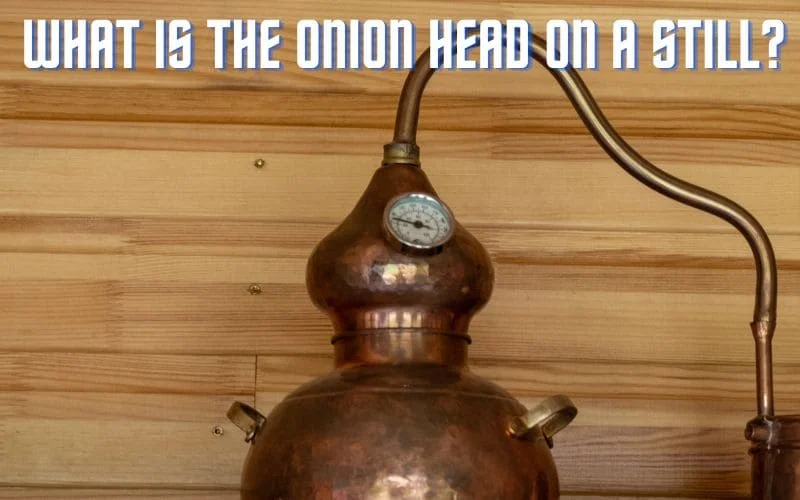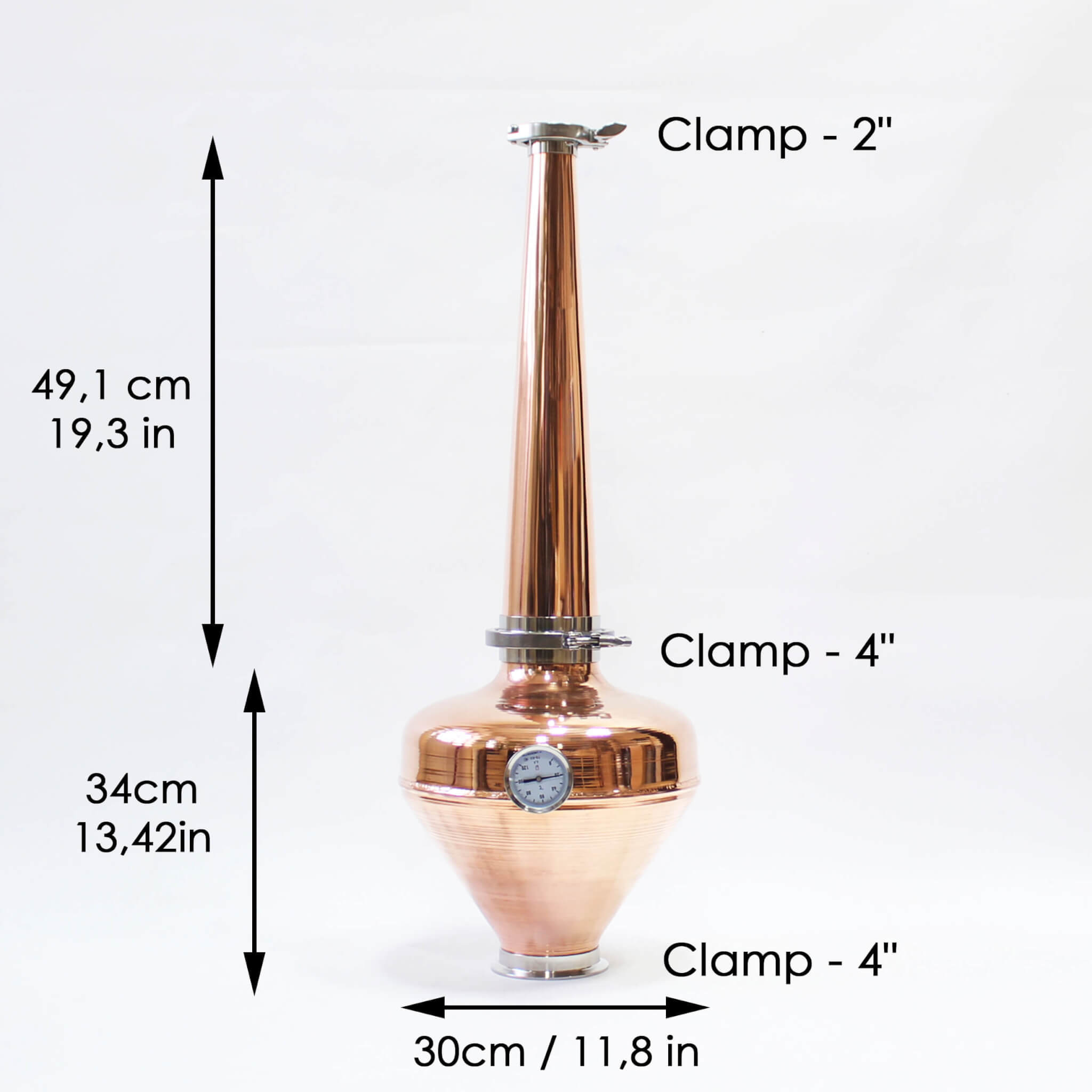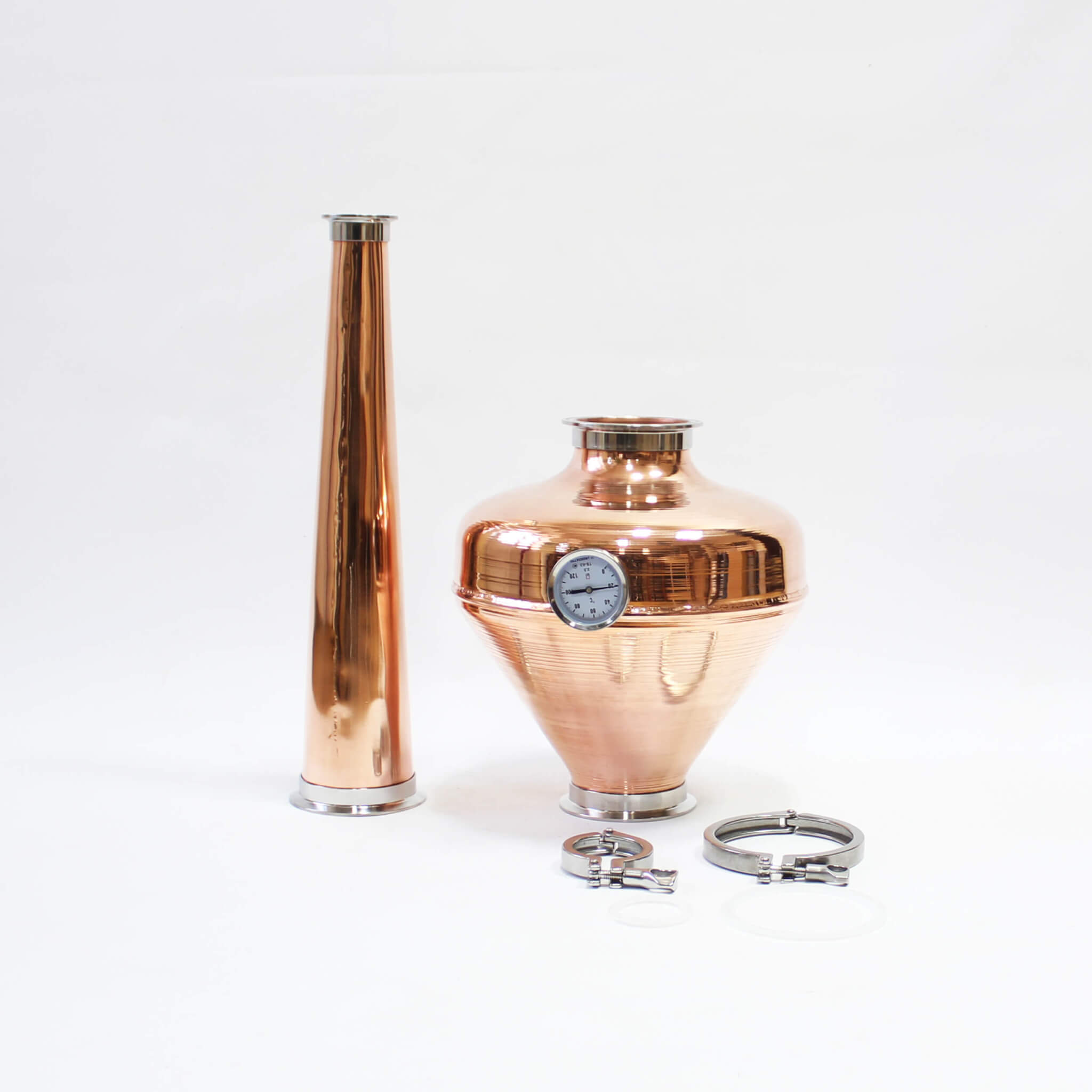What Is the Onion Head on a Still: Function and Purpose Explained

Key Takeaways
- The onion head is a critical component in distillation that enhances vapor reflux and improves the purity of your final spirit.
- Its distinctive bulbous shape facilitates proper condensation and separation of alcohol from unwanted compounds.
- Copper is the preferred material for onion heads due to its superior heat conductivity and natural sulfur-removing properties.
- Proper maintenance of your onion head directly impacts the flavor profile and quality of your distilled spirits.
- Good Ol’ Moonshine provides high-quality copper distillation equipment designed by experts to maximize your distillation efficiency.
The difference between average spirits and exceptional ones often comes down to the equipment you use. If you’ve been exploring the world of distillation, you’ve likely encountered the term “onion head” – a component that plays a crucial role in creating quality spirits, yet remains mysterious to many beginners.
Understanding the function of each part in your distillation setup is essential for producing superior spirits with distinct character and flavor. Good Ol’ Moonshine specializes in providing premium copper distillation equipment that enhances your distilling experience, including expertly crafted onion heads designed to optimize your spirit production. Let’s explore exactly what this vital component does and why it matters so much to your final product.
The Vital Component: What Exactly Is an Onion Head?

“Premium Onion Distiller Cap for Alembic …” from rongyiliuti.en.made-in-china.com and used with no modifications.
“How To Slice an Onion (With Video)” from www.simplyrecipes.com and used with no modifications.
An onion head is a bulbous, rounded section that sits atop the pot or boiler in a distillation apparatus. Also referred to as a “helmet” or “onion dome,” this component earned its name from its distinctive shape that resembles an onion. It serves as the transitional chamber between the boiler where vapors rise and the lyne arm or condenser where those vapors begin their journey back to liquid form.
Historically, onion heads have been a fundamental element in traditional pot stills for centuries, particularly in the production of whiskey, brandy, and other spirits where flavor complexity is desired. The design hasn’t changed significantly over time because its form perfectly serves its function – a testament to the ingenuity of early distillers who developed this shape through observation and experience.
The onion head isn’t merely decorative; it’s an engineered solution to specific challenges in the distillation process. Its expanded chamber creates a space where vapor dynamics can work their magic, affecting everything from spirit purity to flavor development. Without this component, many of the nuanced characteristics that distinguish premium spirits would be difficult or impossible to achieve.
How the Onion Head Powers Your Distillation Process

“Copper Onion Head …” from www.aliexpress.com and used with no modifications.
The magic of an onion head happens largely unseen, as invisible vapors interact within its chamber in ways that fundamentally affect your final spirit. Understanding these mechanisms helps you appreciate why this component is worth investing in and maintaining properly.
Creates Essential Vapor Reflux
One of the onion head’s primary functions is to create reflux – a process where some vapors condense and fall back into the boiler rather than continuing through the still. This reflux action is crucial for producing smoother, cleaner spirits. As hot vapor rises into the cooler onion head, some of it naturally condenses against the walls of the chamber. This condensation, being heavier than vapor, flows back down into the boiler for redistillation.
The level of reflux directly impacts the purity of your spirit. More reflux generally means a cleaner, higher-proof product because it provides additional opportunities for unwanted compounds to separate from the alcohol. The onion head’s design promotes just enough reflux to improve quality without unnecessarily extending distillation time or reducing yield. For those curious about the overall process, understanding how much liquor 10 gallons of mash can make can provide further insights into the efficiency of your distillation setup.
Separates Alcohol from Unwanted Compounds
Distillation is fundamentally a separation process, and the onion head excels at this critical function. As the vapor mixture enters the expanded chamber, different compounds behave differently based on their weight, volatility, and boiling points. The chamber’s shape creates temperature gradients that help separate alcohol from heavier, less volatile compounds.
This separation is particularly important when making cuts – the process of dividing your distillate into foreshots, heads, hearts, and tails. A well-designed onion head provides cleaner transitions between these cuts, making it easier to collect the desirable “hearts” portion of your run while leaving behind unwanted compounds that could affect flavor or safety. For more on distillation, learn about how much whiskey a 5-gallon still can produce.
Distiller’s Note: The onion head’s separation efficiency increases with its surface area. A larger onion head typically provides better separation but requires more energy to heat. Finding the right balance for your specific still size is essential for optimal performance.
Controls Vapor Speed for Better Purity
The expanded chamber of the onion head serves another critical function: controlling vapor speed. When vapor rises from the boiler, it’s moving rapidly in a concentrated column. If this vapor were to move directly into the condenser, it would carry more impurities and result in a rougher spirit. For those interested in the aging process, you might wonder does moonshine age well and how it affects the final product.
Instead, the onion head’s larger diameter forces the vapor to slow down and spread out. This deceleration allows heavier compounds to fall back while lighter, more volatile compounds (primarily ethanol) continue forward. Think of it as a traffic pattern that forces everyone to slow down and follow proper lanes – creating order from chaos and resulting in a smoother flow of the desired compounds.
Anatomy of an Onion Head: Design and Materials

“Copper whiskey helmet Column Onion Bulb …” from copper-pro.com and used with no modifications.
The seemingly simple design of an onion head belies its sophisticated engineering. Every curve and dimension serves a specific purpose in the distillation process. The traditional onion head features a wide, rounded chamber that narrows at both the inlet (where it connects to the boiler) and the outlet (where it connects to the lyne arm or condenser).
This distinctive shape creates varying temperature zones within the chamber. The hottest area remains near the inlet, with progressively cooler zones as vapor moves upward and outward. These temperature gradients are crucial for proper vapor management and separation of compounds based on their volatility.
Copper Construction Benefits
Copper has remained the gold standard for onion head construction for centuries, and for good reason. Its exceptional thermal conductivity allows for precise temperature control during distillation, creating ideal conditions for reflux and separation. When vapor contacts the copper surface, heat transfers quickly and efficiently, enhancing the reflux process.
Beyond its thermal properties, copper acts as a natural catalyst that removes sulfur compounds from your spirit. These compounds, which can create unpleasant odors and flavors, bind to the copper surface during distillation. This natural purification process is one reason why copper distillation equipment consistently produces smoother, cleaner spirits than alternatives. If you’re curious about other factors affecting your spirit, you might wonder does moonshine age well over time?
The Significance of Its Bulbous Shape
The bulbous shape of the onion head isn’t merely traditional—it’s functional by design. The expanded chamber creates increased surface area that maximizes vapor-copper contact, enhancing both the catalytic sulfur removal and the reflux process. This shape also creates the perfect environment for vapor expansion, allowing volatile compounds to separate more effectively. For those interested in the production process, understanding how much whiskey a still can produce is crucial.
The gradual tapering at the top of the onion head helps direct the flow of vapor toward the lyne arm while maintaining optimal pressure within the system. This careful balance of expansion and constriction is what allows the onion head to perform its separation functions so effectively, making it far superior to simple straight pipes or basic caps.
Connection Points to Other Still Components
The integration between the onion head and other still components must be precise for proper function. The lower connection to the pot must form a vapor-tight seal to prevent leakage while allowing for easy disassembly for cleaning. Most quality designs use threaded connections, tri-clamp fittings, or custom-fitted joints depending on the still’s size and intended use.
The upper connection, where the onion head meets the lyne arm or condenser, is equally critical. This junction determines the angle and direction of vapor flow, which influences the final spirit’s character. Many traditional designs incorporate a slight downward angle to enhance reflux, while others maintain a horizontal orientation for different flavor profiles. For those interested in the distillation process, understanding what temperature kills distillers yeast can be crucial for achieving the desired flavor and quality.
Onion Head vs. Other Still Tops: Key Differences

“Pot Still vs Flip Top Still” from www.whiskeystillpro.com and used with no modifications.
Not all still tops are created equal, and understanding the differences between various designs can help you make informed choices about your distillation equipment. The onion head represents just one approach, albeit a time-tested and highly effective one.
Comparison with Helmet Designs
Helmet-style still tops typically feature a more cylindrical shape with less pronounced bulging than onion heads. While they serve similar functions, helmets generally produce less reflux due to their reduced surface area and different vapor flow patterns. This can result in faster runs but potentially less refined spirits depending on your specific recipe and technique. For more insights on the differences between these designs, check out this comparison of copper onion helmets.
Helmets often work well for distillers seeking higher yields with less separation between compounds, such as in some rum productions where more congeners (flavor compounds) are desirable. Onion heads, by contrast, excel at creating cleaner, more refined spirits where separation of unwanted compounds is prioritized.
How It Differs from Basic Expansion Chambers
Simple expansion chambers lack the sophisticated curves and thoughtful design of a proper onion head. While any expansion of the vapor path will create some reflux and separation, basic chambers don’t optimize these processes the way an onion head does. The temperature gradients, surface area, and vapor flow patterns in an onion head are carefully calibrated for maximum effectiveness. For more on refining your distillation process, you might want to learn how much whiskey a 5-gallon still can produce.
Basic expansion chambers might be sufficient for simple distillation tasks or educational demonstrations, but they rarely produce the quality and consistency that serious distillers demand. The refined engineering of an onion head makes a noticeable difference in the final product’s character and purity.
The onion head’s design also incorporates centuries of practical knowledge about vapor dynamics that many modern simplified designs overlook. These subtle design elements—the precise degree of curvature, the ratio of height to width, the thickness of the copper—all contribute to superior performance that basic chambers cannot match.
- Onion heads provide superior reflux action through optimized surface area
- Their bulbous shape creates ideal temperature gradients for compound separation
- Traditional designs incorporate knowledge refined over centuries of practical distilling
- The copper construction offers catalytic benefits that many alternative materials lack
- Their integration with other still components is engineered for optimal vapor flow
When comparing different still top designs, remember that each choice represents a tradeoff between efficiency, flavor profile, and spirit character. Your selection should align with the specific type of spirit you’re producing and the characteristics you want to emphasize in your final product.
Impact on Your Final Spirit Quality

“102,500+ Man Thumbs Up Stock Photos …” from www.istockphoto.com and used with no modifications.
The onion head isn’t just a functional component—it’s a flavor architect that significantly influences your final product. The way vapors interact within this chamber directly affects which compounds make it into your collection vessel and which are left behind or redirected for redistillation. This selective process is what gives different spirits their distinctive character profiles.
When operated correctly, an onion head helps create cleaner separation between the undesirable compounds in the heads and tails while preserving the desirable flavor compounds in the hearts cut. This precision is particularly important when crafting premium spirits where subtle flavor notes make all the difference between average and exceptional products.
Flavor Enhancement Properties
Beyond simple separation, the onion head actively contributes to flavor development through its interaction with the vapor. As alcohol vapors contact the copper surface, chemical reactions occur that reduce sulfur compounds and other unwanted elements that could create off-flavors. This copper contact creates a smoother, more refined flavor profile that’s difficult to achieve with other materials.
Many experienced distillers note that spirits produced with traditional copper onion heads have a distinctively clean yet complex character. The improved reflux action allows for better retention of delicate flavor compounds while eliminating harsh elements, resulting in a more balanced final product with improved mouthfeel and aroma.
Proof Control Capabilities
The onion head design gives distillers greater control over the final proof of their spirits. By affecting the reflux rate, the onion head influences how concentrated the alcohol becomes before entering the condenser. More reflux generally results in higher proof distillate with fewer congeners, while less reflux produces a lower proof with more flavor compounds.
This control allows for customization based on the specific spirit being produced. Vodka production might leverage the onion head’s reflux capabilities to achieve high proof with minimal flavor compounds, while whiskey production might utilize a different approach to retain more of the grain’s character in the final distillate.
Common Troubleshooting for Onion Head Issues

“Onion Head! – YouTube” from www.youtube.com and used with no modifications.
Even the best-designed onion heads can encounter problems that affect distillation efficiency. Recognizing and addressing these issues promptly helps maintain consistent quality in your spirits and extends the life of your equipment.
Dealing with Blockages
Over time, particulate matter from fermentation can accumulate in the onion head, particularly at the narrower connection points. These blockages restrict vapor flow and reduce efficiency, potentially leading to off-flavors in your distillate. If you notice changes in distillation rate or unusual pressure in your system, a blockage may be the culprit.
Regular cleaning is the best preventive measure, but if a blockage occurs during operation, safely shutting down the still and allowing it to cool completely before disassembly is essential. Never attempt to clear blockages while the still is hot or in operation, as this creates serious safety hazards.
Proper Cleaning Techniques
Maintaining the integrity of your onion head requires proper cleaning after each use. A solution of equal parts white vinegar and water effectively removes most residues without damaging the copper. For stubborn deposits, a paste made from salt, flour, and vinegar applied with a soft brush can help restore the copper’s shine and functionality.
Always rinse thoroughly with clean water after cleaning to remove any cleaning solutions that could affect future batches. Allow the components to dry completely before storage to prevent moisture-related issues like verdigris (the green patina that forms on copper) from developing.
Signs Your Onion Head Needs Replacement
Even the highest quality copper onion heads eventually wear out. Thinning copper, visible stress cracks, or persistent leaks at connection points indicate it may be time for a replacement. These structural issues can affect both safety and spirit quality, making timely replacement an important consideration.
Most quality copper onion heads should last for many years with proper care, but their lifespan depends on factors like frequency of use, cleaning practices, and the types of spirits being produced. Inspecting your equipment regularly helps identify potential issues before they become serious problems.
Selecting the Right Onion Head for Your Still

“Businessman Two Choices Stock Photos …” from www.dreamstime.com and used with no modifications.
Choosing the appropriate onion head involves considering several factors related to your specific distillation needs. The right match between your boiler capacity, desired spirit type, and operational goals ensures optimal performance and results. Additionally, understanding how much liquor your mash will produce can help in selecting the suitable equipment for your distillation process.
Size Considerations
The onion head should be proportional to your boiler size for proper function. A general rule of thumb suggests the onion head diameter should be approximately 1/3 to 1/2 the diameter of your boiler. This ratio provides sufficient expansion space for vapor while maintaining efficient reflux action. An undersized onion head can create excessive pressure and limit reflux, while an oversized one may create too much reflux and slow down production unnecessarily.
Material Options Beyond Copper
While copper remains the gold standard, some modern distilleries utilize stainless steel onion heads with copper mesh inserts to provide the catalytic benefits of copper with the durability and lower maintenance of stainless steel. This hybrid approach offers a compromise that works well for some operations, though purists often maintain that all-copper construction provides superior results.
For educational or demonstration purposes, glass onion heads offer the unique advantage of allowing observers to see the distillation process in action. While not practical for commercial production, these transparent versions provide valuable insights into vapor flow patterns and condensation behavior that can enhance understanding of the distillation process.
The Science Behind the Bulb: Why This Shape Works

“52,000+ Modern Scientists Stock Photos …” from www.istockphoto.com and used with no modifications.
The effectiveness of the onion head isn’t just folklore—it’s supported by scientific principles of thermodynamics and fluid dynamics. The bulbous shape creates varying temperature zones that facilitate fractional distillation, where compounds separate based on their different boiling points. As vapor rises into the expanded chamber, it slows down and cools slightly, causing heavier compounds to condense while lighter alcohols continue upward. This natural physical process is enhanced by the precise geometry of a well-designed onion head, which maximizes surface area while maintaining optimal vapor flow characteristics.
From Essential Tool to Better Spirits: The Onion Head’s Legacy

“Copper whiskey helmet Column Onion Bulb …” from copper-pro.com and used with no modifications.
“Tradition in Contemporary Craft Spirits …” from compassohio.com and used with no modifications.
The onion head represents centuries of distillation wisdom translated into physical form. Its enduring design has remained relatively unchanged because it works so effectively at its core functions. From the illicit stills of prohibition-era moonshiners to modern craft distilleries producing award-winning spirits, the onion head continues to play a crucial role in creating distinctive, high-quality distilled products. Discover more about the history of moonshine by exploring Popcorn Sutton’s moonshine legacy.
The knowledge of how to properly design, maintain, and utilize an onion head connects today’s distillers with generations of craftspeople who refined this art through careful observation and practical experience. This connection to tradition doesn’t mean resisting innovation—rather, it provides a solid foundation upon which modern distillers can build their own unique expressions.
Distiller’s Wisdom: “The onion head is where science meets art in distillation. Its shape may seem simple, but the complexity of what happens inside that chamber is what transforms ordinary fermented liquid into extraordinary spirits. Respect this component, and it will reward you with remarkable results.” – Master Distiller
Whether you’re just beginning your distillation journey or looking to refine your craft, understanding and appreciating the onion head’s role gives you greater control over your final product. Good Ol’ Moonshine provides expertly crafted copper distillation equipment, including precision-designed onion heads that help enthusiasts achieve professional-quality results in their spirits production.
Frequently Asked Questions
The specialized nature of distillation equipment often raises questions about best practices, alternatives, and troubleshooting. Here are answers to some of the most common inquiries about onion heads in still design, such as how much whiskey a still can produce.
Can I run a still without an onion head?
Technically, yes—a simple pot still can function with just a boiler connected directly to a condenser. However, this stripped-down configuration sacrifices the significant benefits that an onion head provides. Without an onion head, you’ll likely experience reduced separation of compounds, less reflux action, and potentially harsher flavors in your final spirit.
For neutral spirits like vodka, the absence of an onion head is particularly problematic as it makes achieving high purity much more difficult. For flavor-forward spirits like whiskey or brandy, the lack of an onion head means less control over which flavor compounds make it into your final product. If you’re curious about how much whiskey a still can produce, you might find this article on how much whiskey a 5-gallon still makes insightful.
Some alternative still designs, such as column stills, use different mechanisms to achieve separation and reflux. These designs may not require an onion head specifically, but they incorporate other components that serve similar functions through different means. For instance, understanding how much whiskey a 5-gallon still can produce might help in exploring the efficiency of various still designs.
If you’re considering running without an onion head to save money or simplify your setup, consider that the quality difference in your final product will likely outweigh any short-term savings. The onion head is an investment in better spirits, not merely an optional accessory.
- Without an onion head, expect less reflux and poorer separation of compounds
- Your spirit will likely have less refinement and potentially harsher characteristics
- Temperature control and vapor management become more challenging
- The ability to make precise cuts between heads, hearts, and tails diminishes
- Overall yield of quality spirit typically decreases compared to properly equipped setups
How often should I clean my onion head?
Clean your onion head after every distillation run to prevent buildup of residues that can affect flavor and performance. If you’re running multiple batches of the same recipe in succession, a thorough rinse between runs and a deep cleaning at the end of your production day is generally sufficient. However, when switching between different recipes or spirit types, a complete cleaning is essential to prevent flavor carryover that could contaminate your next batch.
Does the size of the onion head affect distillation speed?
Yes, the onion head’s size directly influences distillation speed and efficiency. A larger onion head creates more surface area for reflux, potentially slowing the process but increasing purity and separation. Conversely, a smaller onion head allows for faster runs but may provide less refinement. When designing or selecting a still, the onion head should be proportional to your boiler size and appropriate for your specific distillation goals—whether that’s maximizing production speed, optimizing flavor profiles, or achieving the highest possible purity.
Can I make my own onion head at home?
Creating a functional onion head requires significant metalworking skills, appropriate tools, and food-grade materials. While some experienced craftspeople successfully build their own distillation equipment, the precision required for proper function and safety makes this challenging for beginners. The connections must be perfectly sealed to prevent vapor leaks, and the material (typically copper) must be of appropriate thickness and purity for safe distillation.
If you’re considering a DIY approach, research local regulations carefully, as manufacturing distillation equipment may be restricted in some areas. For most enthusiasts, purchasing a professionally manufactured onion head ensures proper function, safety, and compliance with applicable standards. Good Ol’ Moonshine offers quality copper components designed specifically for optimal distillation results.
Why is copper the preferred material for onion heads?
Copper has remained the material of choice for onion heads due to its unique combination of properties that directly benefit the distillation process. Its excellent thermal conductivity ensures even heat distribution and precise temperature control, which are crucial for proper reflux and separation. This conductivity allows the onion head to maintain the ideal temperature gradient from bottom to top, facilitating the separation of different compounds based on their volatility.
Perhaps even more important than its thermal properties is copper’s ability to act as a catalyst during distillation. It naturally removes sulfur compounds that can create unpleasant aromas and flavors in spirits. These sulfur compounds, which are often present in fermented mash, bind to the copper surface during distillation and are effectively removed from the vapor stream. This natural purification process results in cleaner, smoother spirits that would be difficult to achieve with other materials.




